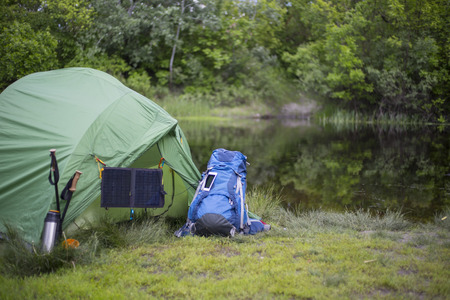Eco-Friendly Camping Gear Essentials
Heading out into the great outdoors doesn’t mean you have to leave a big footprint behind. Choosing sustainable camping gear helps protect nature while still giving you all the comfort and convenience you need. Whether youre a weekend warrior or a seasoned camper, having the right eco-friendly gear makes a huge difference. Here are some must-have items that are better for the planet and just as effective as their traditional counterparts.
Top Sustainable Gear Picks
From lighting your campsite to keeping yourself clean, theres an eco-friendly option for almost everything. Heres a look at some essentials:
| Gear | Eco-Friendly Alternative | Why It’s Better |
|---|---|---|
| Lanterns & Flashlights | Solar-powered lanterns | No batteries needed, renewable energy source |
| Soap & Cleaners | Biodegradable soap | Breaks down naturally, safe for soil and water |
| Cooking Supplies | Reusable utensils and cookware | Reduces single-use plastics, long-lasting |
| Water Bottles | Stainless steel or BPA-free reusable bottles | Keeps waste out of landfills, safer for health |
| Campsite Furniture | Sustainable materials like bamboo or recycled plastic chairs | Eco-conscious materials reduce environmental impact |
Small Swaps, Big Impact
You don’t have to replace everything at once. Start by swapping out a few key items with greener versions. Over time, these small changes can make a big impact on preserving our natural spaces.
Packing Tips for Eco Gear
- Pack light but smart: Choose multi-functional gear to reduce waste and weight.
- Avoid single-use items: Bring reusable containers, utensils, and bags.
- Select quality over quantity: Durable gear lasts longer and reduces landfill waste.
Pro Tip:
If you’re shopping for new gear, look for products labeled with certifications like “Fair Trade,” “Recycled Materials,” or “Leave No Trace Partner.” These labels indicate companies that prioritize sustainability in their manufacturing process.
By choosing eco-friendly camping gear, youre not only enhancing your outdoor experience but also doing your part to preserve nature for future generations.
2. Green Campsite Setup Tips
Setting up your eco-friendly campsite the right way helps preserve nature for everyone to enjoy. From where you pitch your tent to how you manage your waste, every choice matters. Here’s how to keep it green and low-impact while still having a great time outdoors.
Follow Leave No Trace Principles
The Leave No Trace (LNT) principles are the foundation of sustainable camping in the U.S. These seven simple guidelines help minimize your impact on the environment:
| Principle | Description |
|---|---|
| 1. Plan Ahead and Prepare | Know the regulations and special concerns for the area youll visit. Proper planning helps avoid damage to natural resources. |
| 2. Travel and Camp on Durable Surfaces | Stick to established trails and campsites to prevent erosion and habitat destruction. |
| 3. Dispose of Waste Properly | Pack it in, pack it out — including food scraps, hygiene products, and trash. |
| 4. Leave What You Find | Don’t take rocks, plants, or historical artifacts as souvenirs. |
| 5. Minimize Campfire Impact | Use a camp stove or existing fire rings instead of making new ones. |
| 6. Respect Wildlife | Observe animals from a distance and don’t feed them — it can harm their health and change natural behaviors. |
| 7. Be Considerate of Others | Keep noise levels down and respect other campers’ space and experience. |
Smart Tent Placement
Your tents location affects both your comfort and the environment. Choose wisely with these tips:
- Select a durable surface: Look for gravel, dry grass, or packed dirt instead of soft vegetation or mossy areas.
- Avoid water sources: Set up at least 200 feet away from lakes, streams, or rivers to protect wildlife habitats and reduce contamination risk.
- Avoid fragile areas: Don’t camp in meadows, wetlands, or alpine tundra where recovery from human impact takes longer.
- Use existing sites: If a designated campsite is available, use it rather than creating a new one.
Eco-Friendly Waste Management
Keeping your campsite clean is about more than just tidiness — it’s about protecting ecosystems. Here are some easy waste management habits to follow:
Trash & Recycling
- Bring reusable containers: Reduce single-use plastics by packing snacks and meals in washable containers.
- Packing out: Everything you bring in should leave with you — yes, even biodegradable items like orange peels or sunflower seeds.
- Sort waste if possible: Some campgrounds offer recycling bins; if so, separate recyclables accordingly.
Human Waste
- If theres a toilet: Use established restrooms whenever available.
- No facilities? Dig a cathole 6-8 inches deep and at least 200 feet from water sources, trails, and campsites. Cover it up completely when done.
- Use a WAG bag: In sensitive areas (like deserts or alpine zones), pack out human waste using specially designed bags approved for disposal in trash systems.
Dishwater Disposal
- Scoop solids first: Strain food scraps before dumping dishwater.
- Bury gray water: Scatter or bury dishwater at least 200 feet away from any water source.
- No soap is best: If needed, use only biodegradable soap — but sparingly!
Caring for nature while camping doesn’t mean sacrificing comfort — just being mindful of your choices makes a big difference. Keep these tips handy next time you head out into the wild!

3. Sustainable Cooking and Food Storage
When youre out in the wild, cooking meals and storing food responsibly plays a big role in keeping your campsite eco-friendly. Making smart choices not only helps preserve nature but also keeps you and local wildlife safe. Heres how to cook and store food the sustainable way while camping.
Eco-Friendly Cooking Gear
Choosing the right cooking equipment can reduce your environmental impact. Instead of single-use or disposable items, go for reusable and refillable options. Check out some popular sustainable gear below:
| Item | Eco-Friendly Option | Why It’s Better |
|---|---|---|
| Fuel Canisters | Refillable propane or isobutane canisters | Cuts down on waste from single-use containers |
| Cookware | Stainless steel or cast iron pans | Durable, long-lasting, and non-toxic |
| Utensils | Bamboo or metal utensils | Reusable and biodegradable or recyclable |
Sustainable Food Choices
The food you bring matters too. Try to pack organic, locally sourced, or bulk foods that come with minimal packaging. Avoid overly processed snacks that generate trash or require refrigeration.
Smart Meal Planning Tips:
- Plan meals ahead to avoid food waste.
- Pre-chop veggies and store them in reusable silicone bags.
- Avoid single-use plastic—opt for beeswax wraps or stainless steel containers.
- Bring dry goods like oats, rice, pasta, and nuts in glass jars or cloth bags.
Bear-Safe and Wildlife-Proof Storage
No matter where youre camping in the U.S., keeping food away from animals is a must. In bear country especially, use certified bear-resistant containers or lockers provided at campsites. Even outside of bear zones, raccoons and other critters will try to get into your supplies if they’re not stored correctly.
| Storage Method | Best For | Eco Benefit |
|---|---|---|
| Bear Canisters | Backcountry trips in bear territory | Keeps wildlife safe and prevents food loss |
| Coolers with lockable latches | Car camping near known wildlife areas | Reusable and reduces temptation for animals |
| Hanging food bags (bear hang) | No-container zones or lightweight backpacking | No plastic involved; uses minimal gear |
Quick Tips for Wildlife-Safe Food Storage:
- Never leave food unattended—even during meal prep.
- Store all scented items (like toothpaste and sunscreen) with your food.
- Aim to cook at least 100 feet away from your sleeping area.
- Clean up thoroughly after every meal—no crumbs left behind!
Sustainable cooking and smart food storage arent just about being eco-conscious—theyre about creating a safer, cleaner campsite for everyone who comes after you. With a little planning and the right gear, eating well outdoors can be both delicious and green.
4. Eco-Conscious Activities and Recreation
Spending time outdoors is one of the best parts of camping, but its important to choose activities that respect and protect the environment. Eco-conscious recreation helps preserve natural spaces while still allowing you to have fun and connect with nature. Here are some low-impact outdoor activities that align with sustainable camping practices.
Low-Impact Activities That Leave No Trace
Engaging in low-impact activities means enjoying nature without disturbing wildlife or damaging the ecosystem. These activities don’t require major equipment or infrastructure, making them perfect for eco-friendly campers.
| Activity | Why It’s Eco-Friendly |
|---|---|
| Hiking | Stick to marked trails to avoid harming plants and wildlife habitats. |
| Birdwatching | Encourages quiet observation and appreciation of nature without physical impact. |
| Kayaking or Canoeing | Non-motorized boats reduce water pollution and noise disturbance. |
| Nature Photography | Captures beauty without taking anything from the environment. |
| Stargazing | No equipment required—just a clear night sky and minimal light pollution. |
Tips for Responsible Outdoor Fun
- Plan ahead: Choose destinations that support conservation and limit visitor numbers to avoid overcrowding.
- Stay on trails: Avoid trampling vegetation or creating new paths.
- Use eco-friendly gear: Bring reusable water bottles, solar-powered gadgets, and biodegradable soaps if needed.
- Observe wildlife from a distance: Don’t feed animals or try to touch them—your presence should be as invisible as possible.
Create a Connection with Nature
The goal of eco-conscious recreation is not just to minimize harm, but also to foster a deeper connection with the natural world. When you kayak down a quiet river or listen to birdsong on a morning hike, you’re building respect for the environment—and that’s what sustainable camping is all about.
5. Responsible Fire Practices and Waste Disposal
Keeping your campsite eco-friendly means being smart about how you use fire and how you handle waste. Not only does this protect nature, but it also helps preserve the beauty of our parks for future campers. Let’s take a look at how to responsibly manage fires and dispose of waste while camping in the U.S.
Safe Campfire Practices
Campfires are a classic part of camping, but they come with risks. Wildfires can start from one small spark, especially during dry seasons. Always follow local fire regulations and consider these tips:
- Check fire bans: Many parks have seasonal restrictions due to fire danger.
- Use established fire rings: If fires are allowed, always use designated fire pits or rings.
- Keep it small: A small, controlled fire is safer and easier to put out.
- Never leave a fire unattended: Always have water or a shovel nearby to extinguish flames quickly.
- Fully extinguish your fire: Douse with water, stir ashes, and douse again until cool to the touch.
Campfire Alternatives
If youre camping in an area where fires are banned or if you want to lower your impact even more, try these alternatives:
| Alternative | Description | Eco Benefit |
|---|---|---|
| Portable camp stoves | Gas or alcohol stoves for cooking meals safely and efficiently | No firewood needed; low risk of wildfire |
| LED lanterns & headlamps | Bright, battery-powered lighting options for night use | No smoke or open flame involved |
| Solar-powered lights | Rechargeable lights powered by sunlight during the day | Sustainable energy source; reusable |
Human Waste Disposal
If your campsite doesn’t have restrooms, it’s important to handle human waste properly to avoid polluting soil and water sources. Here are your main options:
Catholes (for backpacking or remote sites)
- Dig a hole 6–8 inches deep and at least 200 feet away from water sources, trails, and campsites.
- Bury all waste and cover with natural materials like soil or leaves.
- Pack out used toilet paper in a sealed bag unless using biodegradable TP that can be buried.
Portable Toilets or Wag Bags (preferred in fragile areas)
- Avoids contamination of sensitive ecosystems.
- Some areas require pack-out systems—check park rules before heading out.
Food Waste Management
Leftover food and trash can attract wildlife and disrupt ecosystems. Follow these simple rules:
- Store food securely: Use bear-proof containers or hang food when required by local guidelines.
- No scraps left behind: Pack out all food waste—even crumbs!
- Avoid feeding wildlife: It’s harmful for animals and dangerous for humans.
Quick Tip:
Create a mini trash station at your site with separate bags for recyclables, compostables (if allowed), and landfill items. This makes it easier to sort waste and pack it out properly.
The key takeaway? Treat nature with respect. Every action—big or small—makes a difference in preserving our wild spaces.
6. Leaving the Campsite Better Than You Found It
Eco-friendly camping isn’t just about what you bring—its also about what you leave behind. One of the most rewarding parts of sustainable camping is knowing your presence actually helped the environment. By adopting a few simple habits, you can make sure your campsite—and the trails around it—are cleaner and healthier than before you arrived.
Adopt Trail Cleanup Habits
Bring a small trash bag on every hike or walk from your campsite. Picking up litter—even if its not yours—is a quick way to give back to nature. Many parks and forests lack the resources to keep trails spotless, so campers like you play a big role in keeping these places beautiful.
Trail Cleanup Essentials
| Item | Purpose |
|---|---|
| Reusable Gloves | Protect your hands while picking up debris |
| Trash Bag or Reusable Sack | Collect trash without creating more waste |
| Tongs or Grabber Tool | Avoid touching sharp or dirty objects directly |
Protect Native Plants and Wildlife
Stick to established trails and campsites to avoid trampling fragile vegetation. If youre camping in an area with native plants, resist the urge to pick flowers or move rocks—they often serve as habitats for small creatures. If you spot wildlife, observe from a distance and never feed them.
Respecting Nature Tips
- Avoid walking off-trail to prevent soil erosion and damage to plant life
- Don’t stack rocks or disturb natural features—it can displace insects and small animals
- Learn which plants are native or endangered in the area before your trip
Mindful Packing for Minimal Impact
Packing smart helps reduce waste and makes cleanup easier. Bring reusable containers, utensils, and eco-friendly toiletries. Aim for zero single-use plastics when possible. Before leaving, do one last sweep of your site to collect micro-trash like bottle caps or food wrappers.
Sustainable Packing Checklist
| Item | Why It Matters |
|---|---|
| Reusable Food Containers | Cuts down on disposable packaging waste |
| Bamboo or Metal Utensils | Avoids single-use plastic cutlery |
| Biodegradable Soap & Toothpaste | Keeps water sources safe from harmful chemicals |
| Pack-Out Trash Bag | Makes it easy to carry out all waste, including micro-trash |
Your Presence Can Be a Positive Force
Camping responsibly isnt just about minimizing harm—its about actively improving the spaces we love. Whether youre picking up litter, respecting wildlife, or packing mindfully, each action adds up. When every camper takes this approach, we create a culture that values and protects our wild places for generations to come.


